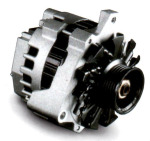
Your vehicle’s alternator is one of those parts you generally never think about, until it fails and sends you to the repair shop. So, here’s quick look at everything you need to know about it.
What does the alternator do? It charges the vehicle’s battery and helps power electrical accessories — lights, radio, etc.
How does it work? In a nutshell, it creates AC power that is stored in the battery and converted to DC power to operate the vehicle’s accessories. A pulley connected to the alternator and driven by the engine’s serpentine belt spins it to generate the power.
It’s important because… While the battery is a power storehouse, its power doesn’t last long when a vehicle is started and items such as the radio, lights and heater are turned on. The alternator continually charges the battery to keep everything running and ensure there’s enough power to start the car the next morning.
It might be going bad if… The engine labors or is slow to start, very much like a weak or dead battery. This is because a weak or dead battery is a casualty of a bad alternator. If the alternator is going bad, it won’t sufficiently charge the battery. Also, a dashboard light that illuminates and says “ALT” or “CHARGE” or shows a battery symbol is an indicator the alternator is going bad and should be inspected immediately.
You shouldn’t wait because… There generally won’t be much of a clue before the alternator goes bad, but when it does, don’t wait to get it checked out — and don’t plan to drive too far. When the alternator fails — indicated by the dash light or symbol — you’ll only have a few minutes of battery power to keep your vehicle going. Quickly find a safe place to pull over before the vehicle stops all together.
Give Douglas Automotive Repair a call today if you’re experiencing problems with your alternator!
This entry was posted in Alternator and tagged Alternator, Battery Light
